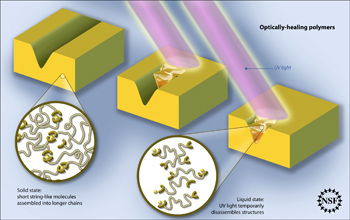All Images
News Release 11-083
Imagine: Material That If Scratched, You Can Quickly and Easily Fix Yourself, With Light Not Heat
Discovery of self-corrective healing process for polymer detailed this week in the journal Nature
This material is available primarily for archival purposes. Telephone numbers or other contact information may be out of date; please see current contact information at media contacts.

Schematic of optically healing polymers. The specially designed polymer molecules that make up the solid item can be disassembled by the UV light so that they flow and fill in the cracks. When the light is turned off, the molecules reassemble themselves and the filled cracks become rigid again.
Credit: Zina Deretsky, National Science Foundation, after Burnworth et al., Nature, April 21, 2011
Download the high-resolution JPG version of the image. (401 KB)
Use your mouse to right-click (Mac users may need to Ctrl-click) the link above and choose the option that will save the file or target to your computer.

Play Audio
Audio transcript from April 19, 2011 Tele-press conference announcing the discovery of polymers that may be healed using light as opposed to heat, featuring: Andrew Lovinger, polymer program director in the Division of Materials Research at the National Science Foundation; Christoph Weder, director and chair of Polymer Chemistry and Materials at the Adolphe Merkle Institute at the University of Fribourg in Switzerland and Lisa-Joy Zgorski, also of the National Science Foundation.
Credit: NSF

Researchers at Case Western Reserve University say fixing scratches on cars and furniture may be cheap and easy to do yourself in the not-too-distant future. Together with partners in the USA and Switzerland, they have developed a polymer-based material that can heal itself when placed under ultraviolet light for less than a minute. View a video about the self-healing polymer that fixes scratches.
Credit: Case Western University


